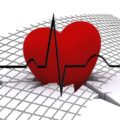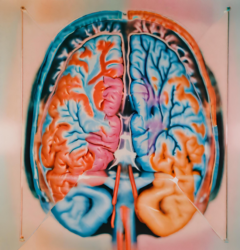Although it is well known that muscles need protein to function, that the brain also needs protein is not common knowledge. In fact, the conventional interpretation of brain fuel leads many to believe that the brain relies almost entirely on glucose for survival. This is largely based on the oft-quoted statement that the brain represents only 2% percent of total body weight but consumes 20 % of the total glucose. Indeed, current research suggests that under normal, resting conditions, the brain consumes ~5.6 mg glucose per 100 g of human brain tissue per minute. That is an enormous amount of glucose. With injury, those numbers surely increase.
With that in mind, the shorthand assumption has become that the brain needs mainly sugar to survive and therefore carbohydrates are key to brain function. While to some degree this is true, it grossly oversimplifies the chemistry involved in brain and body metabolism, forgetting not only that mitochondria require micronutrients, vitamins, and minerals, to process said carbohydrates, but also, that other macronutrients, like proteins and fats, are necessary substrates for bioenergy, not to mention a whole host of other critical processes, like protein and lipid synthesis, the building blocks of any cell.
Macronutrients
In the brain and other compartments of the body, fuel source capabilities and preferences vary considerably. In the heart, for example, free fatty acids are preferred, unless or until there is injury and/or hormone changes (yes, hormones affect heart function and fuel preference) and then glucose becomes more prominent. How well this transition is handled and how effectively the cells manage the different fuel sources is part of what is called metabolic flexibility. As you might suspect, the more metabolically flexible one is, the more likely one is to survive an acute illness.
As was mentioned previously, in the musculature, protein, (and the amino acids therewith), fatty acids, and carbohydrates are all used, although there is much debate on how much of each and relative to which types of activity. Nevertheless, muscles need protein, perhaps far more than any other tissue. With athletes, this is a given. Performance hinges on one’s ability to balance, and really, outpace the breakdown of proteins caused by the demands of training or competition. Similarly, though less well appreciated, the synthesis of muscle protein must outpace the breakdown of proteins if one is to maintain health and any sort of muscle tone.
A skewed balance between protein synthesis and protein breakdown is common among the chronically ill, especially in patients with myopathy and myalgia (muscle weakness and pain) and cachexia (the catabolism of muscle proteins associated with an array of conditions including cancer). Among the more common contributing factors, a seemingly obvious one at that is a lack of protein in the diet (lack of activity follows as a close second). The high carbohydrate, low nutrient diets that are common not only across Western populations but recklessly promoted by western medicine are deleterious to health.
What happens when dietary proteins are low or insufficient? A whole slew of compensatory actions are enacted both in the body and in the brain. Locally, muscle wasting or catabolism begins. Muscle tissue is broken down, and consumed, as an emergency fuel source and the synthesis of new proteins slows. In other words, that optimal cycle of increased protein synthesis to protein breakdown is reversed and muscle wasting begins.
Low Protein and the Brain: Energy Sensors and Survival Protocols
When protein stores become low enough, brain survival mechanisms kick in. Namely, an important set of nuclei in the hypothalamic region of the brain called the orexin/hypocretin neurons, stop firing and cease wakefulness. We have talked about these neurons before, here and here. The orexin or hypocretin neurons (same neurons, different names), are the ATP or energy sensors of the brain responsible for sensing when brain ATP becomes dangerously low and activating survival protocols. One such protocol is decreased wakefulness. That is, when ATP is low, the orexin/hypocretin system kicks in, stops firing, and puts us to sleep. Sleep is a key survival mechanism, allowing for the reallocation of resources to vital functions. Think about it for a minute, if there is only enough ATP floating around to maintain breathing and heart function, wakefulness goes out the window.
Another way we can shut down the orexin/hypocretin system is via increased temperature. Think fever. The orexin/hypocretin neurons are very sensitive thermosensors. And to make things even more interesting, this system regulates our motivation to eat and modulates pain. So when the orexin/hypocretin system is dysregulated, we cannot stay awake, have no motivation to eat, and our body hurts all over. Sound familiar? It should. These brain nuclei control what Hans Selye described as ‘sickness behaviors’; behaviors that every organism employs when ill, no matter the cause of the illness.
Interestingly, while many parts of the brain consume glucose like fiends, the orexin/hypocretin neurons do not like glucose at all. In fact, these neurons shut down entirely and stop firing in the presence of glucose. When extracellular glucose levels are high, an inward rectifying potassium (K+) channel that is ATP dependent kicks in, and intracellular ATP is allocated to open K+ channels and flood the cell with the inhibitory K+ ions. The K+ hyperpolarizes the cell and prohibits it from firing. So high glucose or too many dietary carbohydrates, shut down these neurons, force us to sleep, decrease our motivation to eat, and increase pain sensitivity. From a behavioral standpoint, this explains why many of us feel rotten much of the time.
If high glucose diminishes the firing rate of the orexin/hypocretin neurons, one might wonder what activates these neurons. It turns out that these neurons want dietary protein, or more specifically, amino acids. Through a series of electrophysiological experiments, researchers from Cambridge and elsewhere delineated the fuel source preferences of orexin/hypocretin neurons. The methods were complicated but basically, they used sensors to measure cell firing in different media. More technically, brain cell patch clamps of locally (in culture) and peripherally and centrally (live mice fed various diets, activity levels measured, subsequently terminated, decapitated and brain slice measurements taken) administered amino acids, fatty acids, glucose, and other substrates were used to determine which fuels caused the most robust electrical signals.
They found that orexin/hypocretin neurons fire most strongly in the presence of several amino acids. The most potent among them, in order of potency included: glycine > aspartate > cysteine > alanine > serine > asparagine > proline > glutamine.
The essential amino acid leucine, which is critical for protein synthesis in the musculature, did not evoke detectable membrane current, e.g. induce the neuron to fire. Similarly, neither the fatty acids tested (oleic acid, palmitic acid, and palmitoleic acid) nor glucose evoked a response. While the lack of response to glucose is understandable given that it triggers the potassium currents that hyperpolarize the cell, the lack of response to leucine is surprising. Leucine and the other branched-chain amino acids are critical for muscle protein synthesis and are all the rage in the supplement world.
Also surprising, even though glucose alone causes these neurons to stop firing, glucose plus amino acids induced cell firing in a manner that was synergistic to that of the amino acids alone. That is, the firing rates increased somewhat over and above what the various amino acids alone produced. This tells us that like the rest of the body, the preferred fuels of different nuclei in the brain are a bit more complex and metabolically refined than appreciated. The brain, or at least this set of nuclei in the brain, requires amino acids to function.
One More Thing: Glycine and Glyphosate
Digging a little deeper, if we look at the most potent amino acid, glycine, we see something troubling. Glycine is very active in the brain and spinal cord, binding with its own receptors and capable of initiating all manner of signal transduction pathways by itself and along with other neurotransmitters like GABA and glutamate. In adults, glycine quickly tempers the excitability of motor neurons, auditory processing, pain transmission, and other functions. Glycine is critical for one-carbon metabolism (which is folate- B9 and cobalamin- B12 dependent) and the synthesis of glutathione (a major antioxidant), creatine (phosphocreatine -ATP store for musculature), purine (nucleotides), and heme synthesis (iron complex). It is also a core component of many transporter and channel proteins.
Glyphosate, the key ingredient in Roundup, the herbicide used commercially in all conventionally grown produce and liberally by consumers for landscaping, is a glycine analog. This means that to the degree one is exposed to glyphosate, glyphosate will substitute itself for endogenous glycine, binding to the very same receptors, tricking them into thinking that there is sufficient glycine floating around. Perhaps more importantly, the glyphosate/glycine analog will embed itself into the polypeptide (protein) chains with aberrant or misfolded proteins likely. Misfolded proteins, like poorly designed tools, mean that things just don’t work the way they should. Imagine a hammer with a floppy handle, a drill that doesn’t spin quickly enough, a saw without teeth, etc. Just as building stable products from poor tools is difficult, so too is building healthy humans. While there are no studies to delineate what specific effects the synthetic glycine has on the orexin/hypocretin system, researchers Samsel and Seneff have demonstrated that this type of substitution is deleterious to health in general.
Bottom line: the brain and the body need protein, preferably organic proteins. If you or your loved ones are having health issues, consider reviewing your diet.
We Need Your Help
More people than ever are reading Hormones Matter, a testament to the need for independent voices in health and medicine. We are not funded and accept limited advertising. Unlike many health sites, we don’t force you to purchase a subscription. We believe health information should be open to all. If you read Hormones Matter, and like it, please help support it. Contribute now.
Yes, I would like to support Hormones Matter.
This article was first published on June 28, 2018.
















Hello Dr. Marrs, I’ve never spoken to you before but I just wanted to say hello and I really need your help. I posted a bunch of paragraphs on another article in this website by Dr. Lonsdale (“IT ALL COMES DOWN TO ENERGY”) from May 11, 2022. The first paragraph I wrote on there was extremely long (sorry about that), but I needed to explain everything. I thought it was be easier if you could go to that page and read everything I wrote (when you get a chance). My name on here is “DANDEEMAN”. Lonsdale replied to that first paragraph I wrote, but then didn’t answer my reply to him. I then sent my reply to him again with the SAME paragraph, but I also added more questions and info in it for him. I have about 4 posts in total on that article page and if you could read them all and respond to them I would appreciate it very much because I need help and I can’t get it from anyone else I know (my doctors included). Let me also mention that I just friend requested you on Facebook and I’m at currently on 400 MG of THIAMAX and tomorrow actually is when I’m supposed to go up to 500 MG. No improvement yet AT ALL and I’m not sure if I’m experiencing paradoxical reaction or not. It’s not so obvious where I can tell right now. Everything is explained in detail in my posts on that other page. Thank you
Hi,
If you would like to write up your full case story and allow us to publish on HM as an article, then perhaps we or others can offer more insight. Having said that, yes, worsening of symptoms, even psychological symptoms are common. However, it may be that you are taking too much of something or too little of something else. Without the full story, it is impossible to know.
Thank you Dr. Marrs!
We certainly need protein, but how much of which?
As little as possible, but as much as needed vs a herd of beef?
(The amount of cells, who must be rebuilt multiplied with the dna/ epigenetic/ideal gene expression?)
All the protein, that exceeds the requirements to build up new cells ends probably in the energy metabolism, or remains in the extracellular matrix-space
There is a protein mix called MAP, .from which 98% can be used for anabolic processes (requires only 10 grams daily, depending on extent of non-fat bodymass) They say resorption happens directly in the small intestine without the involvement of stomach acid.
The recent discoveries about uric acid (Dr. Richard Johnson) , show that uric acid drives insuline resistance and decreases eNOS, that leads to high blood pressure, and a decreased oxygen supply
(Hypoxia instead of b1/magnesium deficiency driven pseudo hypoxia, and it leads to high CK levels, because a lack of glucose supply to the muscles leads to burning down the muscle/glutamine , and that leads to more uric acid… a vicious cycle
Or am I wrong?
The study doctor Johnson refers to: Uric acid: From an innocent bystander to a key player in metabolic syndrome
Best regards
Benjamin Kramer